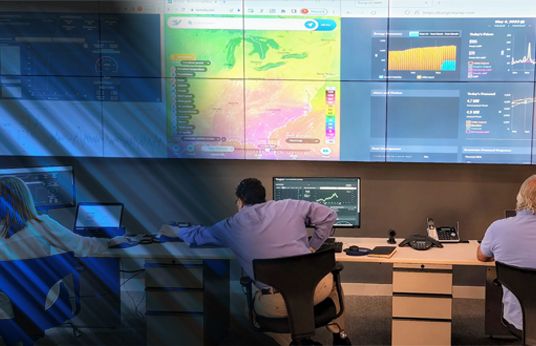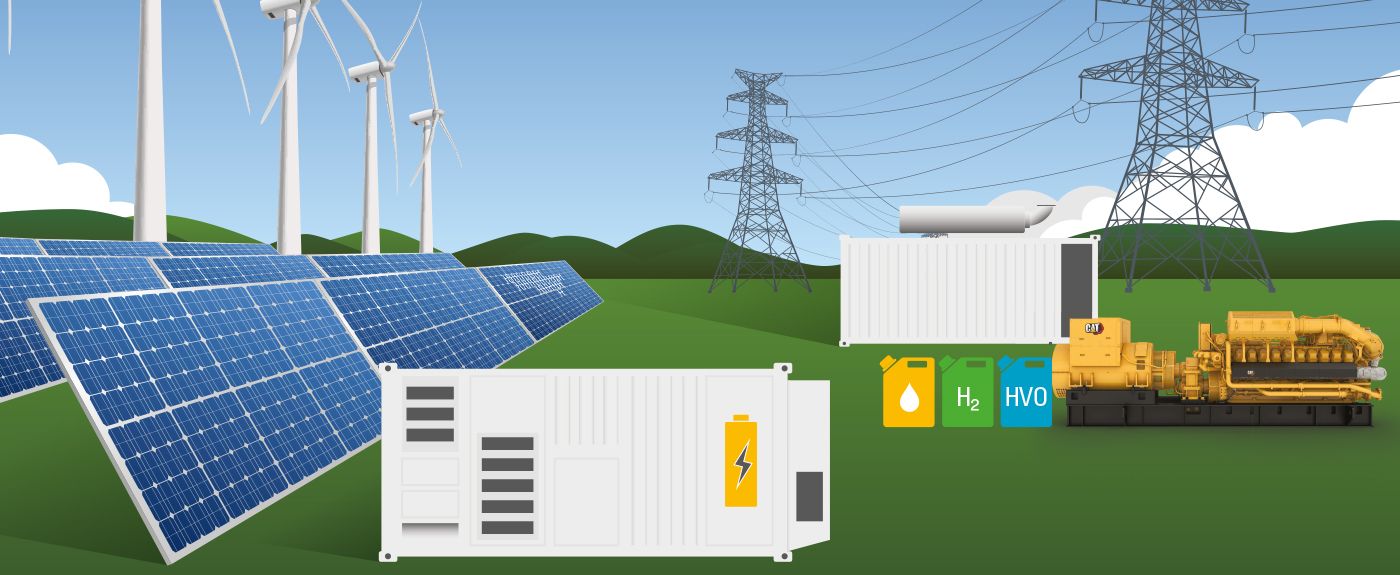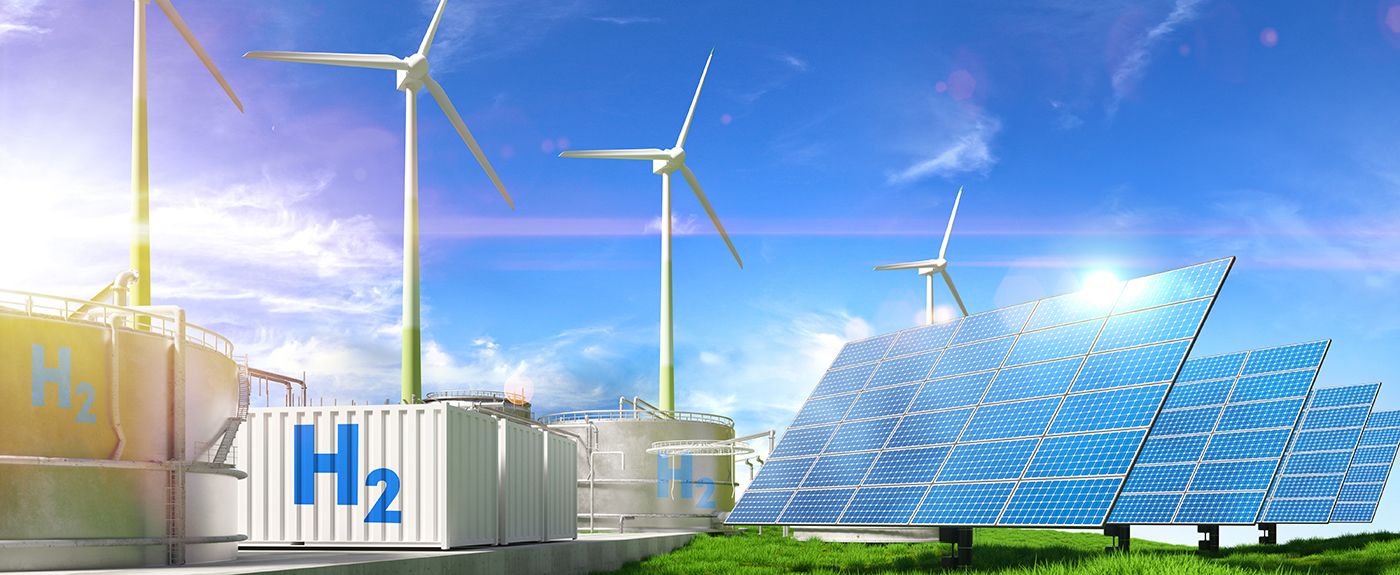

Sign In
Welcome! Sign In to personalize your Cat.com experience
If you already have an existing account with another Cat App, you can use the same account to sign in here
Register Now
One Account. All of Cat.
Your Caterpillar account is the single account you use to log in to select services and applications we offer. Shop for parts and machines online, manage your fleet, go mobile, and more.
Account Information
Site Settings
Security
By John Freeze, Energy Transition Director, Caterpillar Electric Power
Tell me if this sounds familiar: You’re a large energy consumer, maybe in healthcare, education, distribution or transportation. You’re facing pressure — internal, external or both — to increase your energy resiliency, lower your carbon emissions, reduce your energy costs, add capacity for expansion, or some combination of all four. You know you need to act (and soon), but you’re struggling with how to get started implementing a solution.
It’s not an uncommon scenario. A big part of my job involves talking to organizations about their power needs and challenges, and there’s a theme emerging from these conversations: “How do we justify the expense to our leaders and get the sign-off to move forward?”
Here’s my honest answer: If you don’t live and breathe power day and night, it’s really hard to build a business case on your own. That’s why I always suggest partnering with an expert who can conduct an energy assessment, recommend the right blend of solutions, and present a comprehensive proposal and budget to your leadership team.
Of course, we’d love you to choose Caterpillar for that process — but even if you don’t, we still want to help you get started on the right path. Here are the five steps we’ve found most crucial in getting your business case developedand approved:
1. Put in some prep time.
You’ll want to schedule a meeting with your chosen expert — or maybe multiple meetings with various consultants — to kick off the process. Before you get together, gather as much information as possible about your organization’s existing energy situation. Your first conversation will be much more productive if you can provide:
- Current energy provider and rate structure
- Location of electric meter, transformer and switchgear
- Location of gas meter and source of onsite gas, if applicable
- Peak electricity demand information
- Future electricity demand expectations (stable, growing or declining)
- Other energy assets on site (generator sets, batteries, solar, etc.)
At a minimum, be prepared to provide copies of your most recent electric and gas bills. Much of the information above can be gleaned from these statements.
2. Align around your priorities.
Once you get through the technical details, your consultant should zero in on your motivations for action, focusing on your current pain points as well as your future goals. For some organizations, resiliency is key — keeping the power flowing in the event of a storm or grid failure. For others, meeting sustainability objectives or reducing energy costs iscritical.
Has your organization identified its number-one priority? Can you rank other drivers in order of importance to your leadership team? You’ll want to be in lockstep about these goals before moving on to the next step. You’ll also want to let your consultant know which stakeholders will be involved in decision-making. Their priorities — financial versus environmental versus operational, for example — may shape how solutions ultimately get presented.
3. Expect to see an energy assessment.
If any consultant attempts to sell you equipment after the first meeting, that’s a warning sign. In most cases, there’s no single product that can adequately address demands like energy resiliency, sustainability, or cost reduction.
Instead, your consultant should take the information you provide and use it to perform an energy assessment — consulting with technical experts and running various financial models to propose the most viable solution for your organization. That can include:
- Equipment like energy storage systems, solar panels, or microgrids including natural gas or diesel generation
- Energy management technology and distributed energy resources software
- Service agreements that cover ongoing maintenance and repair
The proposal you receive should contain the best blend of energy products, technologies, and services to achieve your goals. There usually are energy outcomes available that will increase resiliency, reduce energy costs, and improve the carbon footprint for your organization.
4. Understand your costs AND your savings.
Once you’re onboard with the content of the proposal, your consultant should work with you on a detailed budget for implementation. What are your upfront capital costs? What are your ongoing expenses? What are your payment options? You should walk away with a firm financing structure, whether that involves partial or 100% financing.
But make sure the budget conversation doesn’t focus solely on what you need to spend. Your consultant should also share how much the proposed solution will save your organization. Can you recoup some of the investment by participating in demand response programs? By avoiding peak energy charges? Can you expect your fuel bill to drop? Your CO2 emissions? Are there incentives available that might reduce your financial outlay? Don’t move forward until you have a good understanding of both costs and savings.
5. Let your consultant help you make the case.
With a comprehensive energy assessment, proposal and budget in hand, you’re ready to make the business case to your leadership team. Don’t feel like you need to go it alone at this stage. Your consultant should offer to handle the bulk of the presentation — outlining recommended solutions, explaining cost and financial models, highlighting short- and long-term benefits, and answering any technical (or unexpected) questions.
Success starts with a conversation.
Can I guarantee your CEO or CFO will sign off on your project if you follow these five steps? No. But I can tell you that the organizations we’ve taken through a similar process have an excellent success rate — if not immediate approval to move forward, then at least a rock-solid foundation on which to build the next iteration.
If you’re ready to get started, we’re ready to help you find the right solution — one that works for you and your leadership team. Request an energy assessment consultation with a Caterpillar expert.

John Freeze
Energy Transition Director
Caterpillar Electric Power
John Freeze is the Energy Transition Director for North America within the Caterpillar Electric Power Energy Transition Commercial Solutions Team. His responsibilities include leading teams to develop Energy as a Service projects across North America. John has spent over twenty years of his career in energy industry, with a significant portion of his time supporting Investor-Owned Utilities, solution providers and large commercial, industrial and institutional companies understand and address the challenges they face during this energy transition.
Generate Savings and Economic Dispatch
Reduce electricity costs and increase energy market program participation with Energy as a Service (EaaS) solutions. Automatically dispatch on-site assets to generate and store energy with an industry-leading technology platform and energy resource management services.

Related Stories
-
How Municipal Utilities Can Address Surging Power Demand
For many municipal utility managers I talk to, it’s getting tougher to continue providing the highest levels of reliability, service, and value. Customer preferences are changing. Some want 100% renewable power overnight; others simply care about cost. Other challenges are mounting, too: New technologies. Increased regulation. Workforce shortages. Budget constraints. And perhaps biggest of all, rising demand.
Learn More -
Act Now to Leverage CHP Tax Credits Up to 50%
The Inflation Reduction Act (IRA), signed into law in August 2022, provides nearly $400 billion in tax credits and incentives over a decade to promote climate change mitigation and stimulate clean energy development in the U.S. It’s the largest single investment in climate and energy in American history — and it includes the highest incentives ever provided by the federal government for combined heat and power (CHP) projects.
Learn More -
Is Your Organization a Good Fit for EaaS? And Is Your EaaS Partner a Good Fit for You?
Our EaaS team at Caterpillar has implemented solutions for all types of operations: from K-12 schools and grocery stores to industrial facilities. The concept — you purchase energy outcomes and turn ownership and upkeep of energy assets over to a third party — works for many organizations. How do you know if yours is one of them?
Learn More -
Demystifying the EaaS Model: Don’t Buy Power Products. Buy Energy Outcomes.
Software as a Service, or SaaS. Today, most applications — everything from Microsoft Office to Google Drive to Salesforce — are hosted by a third-party provider and made available via the web or a mobile app. You don’t need to install or configure anything on your computer, and the SaaS provider handles all maintenance, upgrades, and licensing. It’s more convenient for users and more affordable for businesses.
Learn More -
Hydrogen’s True Colors: A Key to Defining Carbon Intensity
Often referred to as a “clean-burning” fuel, hydrogen is the most abundant chemical substance in the universe because its combustion generates near-zero greenhouse gas emissions at the tailpipe. . It’s also colorless, odorless and burns with a near-invisible flame. So why does nearly every Google search or news story about hydrogen turn up terms like “green,” “blue” and even “pink”?
Learn More -
Distributed Energy Benefits and Grid Systems Integration
Our electric power system faces many challenges, and as the energy landscape evolves to address increased electrification, we will have even greater demand than ever before. Caterpillar is positioned to serve as a trusted partner with the technologies and expertise to provide alternatives to established energy sources and fuels that are reliable and cost effective.
Learn More -
Trends in the Energy Transition
When it comes to the ongoing efforts to decarbonize and reduce greenhouse gas (GHG) emissions, renewables are making up more and more of our sources of power generation, and we think this will continue—for many positive reasons. We have a lot of customers who are setting targets for Environmental, Social, and Governance (ESG) goals, aiming for improved carbon reduction.
Learn More









